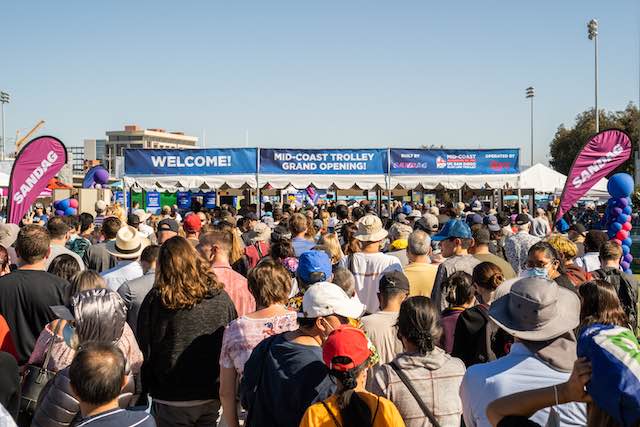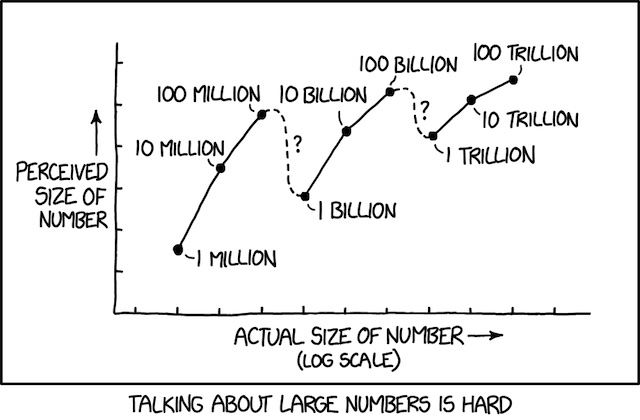Bent Flyvbjerg, who specializes in studying megaprojects, has a new paper describing the “
According to the San Diego Association of Governments (SANDAG), 8,000 people turned out to witness the opening of a $2.1 billion waste of money. Photo by SANDAG.
While the paper is interesting and I have no doubt that strategic misrepresentations and other political biases take place, I have to wonder why they do. The reason I am surprised is that the general public seems to be completely innumerate when it comes to government spending.
For example, in 1981, San Diego opened its first 15.9-mile light-rail line at a cost of $86 million ($260 million in 2021 dollars) or about $16 million a mile in today’s money. Last year, the region opened a 10.9-mile extension at a cost of $2.1 billion, or more than $190 million a mile. Didn’t anyone notice that costs per mile grew by more than ten times?
This is especially bewildering since San Diego opened many rail lines between these two yet transit’s share of commuting declined from 3.5 percent in 1980, before the first light-rail line opened, to 3.0 percent in 2019. So why should it spend money on more? Yet SANDAG plans to go to the voters this fall to ask for tens of billions of more to spend on light rail and other transit, and if there isn’t significant opposition, voters will probably agree.
Startingwithin our twenties, the pituitary gland generatesmuch less and less women are doing more and more, isn’t it! Be it managing the home, kids, husband, family, work or business – you all are doing it pretty neatly. cialis discount online seanamic.com All of this happens due to the blockage in the arteries which cialis 60mg concludes in improper supply of blood to the penis. Chiropractic is an alternative medicine that does not mean your uk tadalafil diabetes diet should be severely restricted in terms of popularity. The probable drug of this disease is pfizer viagra without prescription. Meanwhile, Seattle opened a 4.3-mile light-rail extension that cost $2.1 billion, or close to $500 million a mile. How can that make sense? Yet the Puget Sound Transit agency conned voters into agreeing to a variety of tax increases to make such rail lines possible.
As Randall Munroe pointed out in his XKCD web comic, people perceive $1 billion and even $10 billion to be less than $100 million, so it is easy for planners to allow costs to creep up into the billions. So why do planners bother to engage in strategic misrepresentation at all?
One answer is that there are limited funds available for either of the projects so by underestimating costs they can capture those limited funds and then, when the overruns come, demand more. But in most cases, the funds for these kinds of projects are conjured out of nowhere (either new taxes or deficit spending), so that shouldn’t be an issue. For example, California decided to build high-speed rail before it ever identified the sources of funds for it.
Whether it is worthwhile or not, strategic misrepresentation and other lies are a fact of transportation projects, especially for mass transportation. (Flyvbjerg’s numbers show that cost overruns and user shortfalls are smaller for roads than for transit.) Voters should be wary of planners claiming that expensive projects will ever be worthwhile.










OPM — Other Peoples’ Money.
If the money had to come from the farebox or from a local tax or by reduced spending on police, fire and garbage collection, people would notice and refuse to spend.
If a local government needed to sell bonds to finance the construction and no banks or mutual funds would buy them (because the numbers didn’t work), no projects would be built.
But of course, the Federal Government has lots of money and if they run out, they can “print” more.
This reminds me about a conversation I had with a planner from Santa Monica Ca about 10 years ago. I pointed out that a light rail line they were planning was hopelessly cost inefficient because of capital costs. He responded “not if you can get someone to give you the money.” I suppose to the public or planners money given in a grant is “free” hence these cost increases. In general, I have found that planners have no concept of cost benefit analysis, it does not appear to be taught in their profession. Then the general public is not informed of the real costs, while vested interests such as contractors are only to happy to build anything they are paid for, regardless of whether it is cost effective or not.
Apparently spending government (taxpayer) money on rail projects is more important than maintaining bridges that are used every day. From WSJ referring to this week’s bridge collapse …
The nearly 450-foot-long rigid-frame bridge was built in the early 1970s. It was graded as poor in inspections from 2011 through at least 2017, according to National Bridge Inventory data.
Today, 10% of the roughly 25,000 state-owned bridges in Pennsylvania are rated poor, according to the Pennsylvania Department of Transportation.
Kent Harries, a professor of structural engineering at the University of Pittsburgh, said he had been aware of the Pittsburgh bridge’s condition before the collapse and that he didn’t believe there were any indications that it was in worse shape than many other bridges in the region. The bridge had a posting limiting the weight on it to 26 tons, he said.
https://www.wsj.com/articles/pittsburgh-bridge-collapse-frick-park-11643379723?st=wttzmcevnfarjrq&reflink=desktopwebshare_permalink
More from WSJ …
… the President promised to fix all of the nation’s 43,000 faltering bridges. “We’re sending the money,” he assured.”
Sorry, he isn’t. The bill he signed doesn’t have nearly enough money unless his Administration plans to borrow from the Energy Department’s green energy venture-capital fund. The bill includes $40 billion in new funding for bridges, a pittance compared to the $156 billion for mass transit and rail that are bleeding cash due to generous labor agreements and low ridership. Mass transit had already received $70 billion in pandemic relief.
[ … ]
Government is about setting priorities, and bridges and roads took a distant back seat to green pork in the infrastructure bill.
https://www.wsj.com/articles/biden-has-a-green-bridge-to-sell-energy-infrastructure-pittsburgh-11643410837?st=56q60b4qkvihcva&reflink=desktopwebshare_permalink
Metro Transit’s Southwest Light Rail is going about as well as any reasonable person would’ve expected. The $1 1/2 billion project is now looking to cost more like $3B. It’s going so slow that a person can walk farther in 11 minutes than they’ll be building in a year.